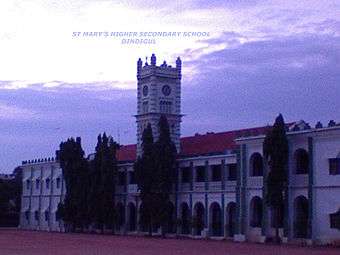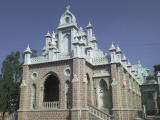St. Mary's Higher Secondary School, Dindigul
| St. Mary's Higher Secondary School Dindigul, Tamil Nadu | |
|---|---|
|
To Know the Truth | |
| Location | |
|
Dindigul, Tamil Nadu, 624 001 India | |
| Information | |
| Religious affiliation(s) | Jesuit (Catholic) |
| Established | 1850 |
| Number of students | 4000+ |
| Medium of language | Tamil, English |
| Website |
stmarys.dindigul maduraijesuits |
 | |
St. Mary's Higher Secondary School (Tamil: புனித மரியன்னை மேல்நிலைப்பள்ளி) in Dindigul, Tamil Nadu, India, was established in 1850 by the Society of Jesus (Jesuit) order in the Catholic church to educate the poor. In early India education was rarely available to the common people. Foreign Jesuits initiated the school to remedy this problem. It began as a high school and later added higher secondary, under the accreditation of the Government of Tamil Nadu Education Board. It is government-aided but also receives funds from Jesuits abroad. It has an experienced academic and sports staff.
Ignatius of Loyola
_Founder_of_the_Jesuits.jpg)
Ignatius of Loyola (Basque: Ignazio Loiolakoa, Spanish: Ignacio de Loyola) (1491– July 31, 1556) was a Spanish knight from a Basque noble family, priest since 1537, who founded the Society of Jesus (Jesuits) and was its first Superior General.[1] Ignatius emerged as a religious leader during the Counter-Reformation. Loyola's devotion to the Catholic Church was characterized by unquestioning obedience to the Catholic Church's authority and hierarchy.[2]
After being seriously wounded at the Battle of Pamplona in 1521, he underwent a spiritual conversion while in recovery. The De Vita Christi written by Ludolph of Saxony inspired Loyola to abandon his previous worldly life and devote himself to labour for God, following the example of spiritual leaders such as Francis of Assisi. He experienced a vision of the Virgin Mary and the infant Jesus while at the shrine of Our Lady of Montserrat in March 1522. Thereafter he went to Manresa, where he began praying for seven hours a day, often in a nearby cave, while formulating the fundamentals of the Spiritual Exercises. In September 1523, Loyola reached the Holy Land to settle there, but was sent back to Europe by the Franciscans.
Between 1524 and 1537, Ignatius studied theology and Latin in Spain and then in Paris. In 1534, he arrived in the latter city during a period of anti-Protestant turmoil which forced John Calvin to flee France. Ignatius and a few followers bound themselves by vows of poverty, chastity, and obedience. In 1539, they formed the Society of Jesus, approved in 1540 by Pope Paul III, as well as his Spiritual Exercises approved in 1548. Loyola also composed the Constitutions of the Society. He died in July 1556, was beatified by Pope Paul V in 1609, canonized by Pope Gregory XV in 1622, and declared patron of all spiritual retreats by Pope Pius XI in 1922. Ignatius' feast day is celebrated on July 31. Ignatius is a foremost patron saint of soldiers, the Society of Jesus, the Basque Country, and the provinces of Guipúzcoa and Biscay.[3]
The youngest of 13 children, Íñigo was only seven years old when his mother died. In 1506, Íñigo adopted the last name "de Loyola" in reference of the Basque city of Loyola where he was born and later became a page in the service of a relative, Juan Velázquez de Cuéllar, treasurer (contador mayor) of the kingdom of Castile.
Jesuit

The Society of Jesus (Latin: Societas Iesu, S.J., SJ, or SI) is a Catholic male religious order that follows the teachings of the Catholic Church. The members are called Jesuits, and are also known colloquially as "God's Marines" and as "The Company", these being references to founder Ignatius of Loyola's military background and the members' willingness to go anywhere in the world and live in extreme conditions. The Society is engaged in evangelization and apostolic ministry in 112 nations on six continents. The Society's founding principles are contained in the document Formula of the Institute, written by Ignatius of Loyola. Jesuits are known for their work in education (founding schools, colleges, universities and seminaries), intellectual research, and cultural pursuits, and for their missionary efforts. Jesuits also give retreats, minister in hospitals and parishes, and promote social justice and ecumenical dialogue.
Ignatius founded the Society after being wounded in battle and experiencing a religious conversion. He composed the Spiritual Exercises to help others follow the teachings of Jesus Christ In 1534, Ignatius and six other young men, including St. Francis Xavier and Bl. Pierre Favre, gathered and professed vows of poverty, chastity, and later obedience, including a special vow of obedience to the Pope. Rule 13 of Ignatius' Rules for Thinking with the Church said: "That we may be altogether of the same mind and in conformity[...], if [the Church] shall have defined anything to be black which to our eyes appears to be white, we ought in like manner to pronounce it to be black."[4] Ignatius' plan of the order's organization was approved by Pope Paul III in 1540 by the bull containing the Formula of the Institute. The opening lines of this founding document would declare that the Society of Jesus was founded to "strive especially for the propagation and defense of the faith and progress of souls in Christian life and doctrine."[5] The Society participated in the Counter-Reformation and later in the implementation of the Second Vatican Council in the Catholic Church.
The Society of Jesus is consecrated under the patronage of Madonna Della Strada, a title of the Blessed Virgin Mary, and it is led by a Superior General, currently Adolfo Nicolás.[6][7] The headquarters of the Society, its General Curia, is in Rome.[8] The historic curia of St Ignatius is now part of the Collegio del Gesù attached to the Church of the Gesù, the Jesuit Mother Church.
Jesuit Madurai Province

The Madurai Province includes the entire State of Tamil Nadu. It is led by Fr. Sebasti L. Raj, S.J., whose office is in Dindigul.
Some of more prominent institutions of the Jesuit Madurai Province are:
St. Joseph's School and St. Joseph's College, Tiruchy (1844), St. Mary's School, Dindigul (1850), St. Mary's School, Madurai (1855), St. Xavier's School (1880) and College (1923), Playamkottai, St. Francis Xavier School, Tuticorin (1884), Loyola College, Chennai (1925), De Britto School, Devakottai (1943), and St. Xavier's College of Education, Palayamkottai (1950). The Jesuits run 15 colleges and 11 secondary schools in Tamil Nadu.
History of Madurai Province

Why would the Jesuits of Tamil Nadu call their Province the Madurai Province? The reasons are historical. Incidentally quite a few Indian Jesuit provinces have names of cities like Bombay, Patna, Jamshedpur and Ranchi. Others – like Andhra, Kerala and Gujarat – have the names of States.
Madurai Province is the oldest Province in India. Jesuit presence in this land of Tamils began since the times of St Francis Xavier. He arrived in Goa on 6 May 1542 and, after four months of stay in Goa, travelled to Tamil Nadu and worked in Manapad, Tuticorin, Madurai and Madras-Mylapore, preaching the good news of Jesus and founding Catholic communities.
After Francis Xavier came Antony Criminali (1520–1549) who was later killed by the Badagas in a raid near Vedalai, Ramnad District,Tamil Nadu. Henri Henriques (1520–1600), Goncalo Fernandez (1541–1621), Robert de Nobili (1577–1656) and others were sent from Goa to the Tamil region to continue the work of evangelisation
About the school

St. Mary's occupies a large area in the heart of Dindigul, five minutes from the bus stand. The Hostel is just opposite the school gate. The environment of the school includes green, spacious grounds and multiple sports fields. The school contains numerous houses: Main Building or Clock House (built in the British period), Jubilee Hall Block, Central Stage with staff rooms, offices, and library, and Fathers House. In 2010 an Engineering Class Block was added.
Besides sports, extracurriculars include drama, handwriting competition, poetry, music, NSS, NCC, JRC, Scouting, and National Green Secretaries for Students.
Branches
Admission to 6th and 9th Standard is by Entrance Exam.
St. Mary's Higher Secondary School provides four branches for class XI & XII: Computer Science, Biology (with maths and physics), Accounting & Commerce, and Vocational Group (EMR, Textile, EDA, Sports).
Generally all students of St. Mary's School pass the X (SSLC) exam. What branch they continue in depends on their marks in this exam. Classes XI and XII have room for additional students but the earlier classes are filled mainly by Christians and by the poor, since it was for them that the school was founded.
Coordinates: 10°21′45.94″N 77°58′26.12″E / 10.3627611°N 77.9739222°E
References
- ↑ Idígoras Tellechea, José Ignacio (1994). "When was he born? His nurse's account". Ignatius of Loyola: The Pilgrim Saint. Chicago: Loyola University Press. p. 45. ISBN 0-8294-0779-0.
- ↑ "The Counter-Reformation". Washington State University. Retrieved 2010-03-28.
- ↑ "Summer Fiestas" (PDF). euskadi.net. Retrieved 2008-07-24.
- ↑ Loyola, Ignatius; Rules for Thinking with the Church (1999). Bettenson, Henry, ed. Documents of the Christian Church (3rd ed.). Oxford: Oxford University Press. pp. 364–367. ISBN 0-19-288071-3. Retrieved 23 February 2010.
- ↑ Formula
- ↑ News on the elections of the new Superior General
- ↑ africa.reuters.com, Spaniard becomes Jesuits' new "black pope"
- ↑ Curia Generalizia of the Society of Jesus
